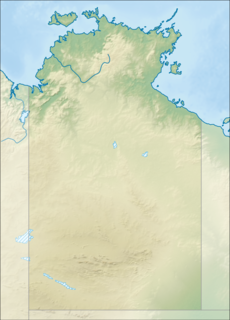
Litchfield National Park, covering approximately 1500 km2, is near the township of Batchelor, 100 km south-west of Darwin, in the Northern Territory of Australia. Each year the park attracts over 260,000 visitors.

Arnhem Land is a historical region of the Northern Territory of Australia. It is located in the north-eastern corner of the territory and is around 500 km (310 mi) from the territory capital, Darwin. In 1623, Dutch East India Company captain Willem Joosten van Colster sailed into the Gulf of Carpentaria and Cape Arnhem is named after his ship, the Arnhem, which itself was named after the city of Arnhem in the Netherlands.

In Australia, a station is a large landholding used for producing livestock, predominantly cattle or sheep, that need an extensive range of grazing land. It corresponds to American ranches that operate under the Taylor Grazing Act of 1934 on public lands. The owner of a station is called a pastoralist or a grazier.
Maningrida is an Aboriginal community in the heart of the Arnhem Land region of Australia's Northern Territory. Maningrida is 500 km (311 mi) east of Darwin, and 300 km (186 mi) north east of Jabiru. At the 2016 census, Maningrida had a population of 2,308.

Anna Creek Station is the world's largest working cattle station. It is located in the Australian state of South Australia.

Kintore is a remote settlement in the Kintore Range of the Northern Territory of Australia about 530 km (330 mi) west of Alice Springs and 40 km (25 mi) from the border with Western Australia. At the 2016 census, Kintore had a population of 410, of which 376 identified themselves as Aboriginal Australians.

A sheep station is a large property in Australia or New Zealand whose main activity is the raising of sheep for their wool and meat. In Australia, sheep stations are usually in the south-east or south-west of the country. In New Zealand the Merinos are usually in the high country of the South Island. These properties may be thousands of square kilometres in size and run low stocking rates to be able to sustainably provide enough feed and water for the stock.

In Australia, a cattle station is a large farm, the main activity of which is the rearing of cattle. The owner of a cattle station is called a grazier. The largest cattle station in the world is Clifton Hills Station in South Australia, which covers an area of 24,677 square kilometres.
Historically, an outstation was a subsidiary homestead or other dwelling on Australian sheep or cattle stations (ranches) which were large enough to have more than a day's travel between different parts of the property.
The Pintupi are an Australian Aboriginal group who are part of the Western Desert cultural group and whose homeland is in the area west of Lake MacDonald and Lake Mackay in Western Australia. These people moved into the Aboriginal communities of Papunya and Haasts Bluff in the west of the Northern Territory in the 1940s–1980s. The last Pintupi to leave their traditional lifestyle in the desert, in 1984, are a group known as the Pintupi Nine, also sometimes called the "lost tribe".

Carnamah is a town in the Mid West region of Western Australia, about 307 kilometres (191 mi) north of Perth along the Midlands Road. According to 2006 census, the population of the town is approximately 496.

Utopia is an Aboriginal Australian homeland formed in November 1978 by the amalgamation of the former Utopia pastoral lease with a tract of unalienated land to its north. It covers an area of 3,500 square kilometres, transected by the Sandover River, and lies on a traditional boundary of the Alyawarra and Anmatjirra people, the two language groups which predominate there today. The name is probably a corruption of Uturupa, which means "big sandhill", a region in the north-west extremity of the area.

Amata, formerly known as Musgrave Park, is an Aboriginal community in the Anangu Pitjantjatjara Yankunytjatjara Lands in South Australia, comprising one of the six main communities on "The Lands".
Yiyili is a small Aboriginal community, located 110 km west of Halls Creek in the Kimberley region of Western Australia, within the Shire of Halls Creek.

Yandeyarra is a large Aboriginal community, located in the Pilbara region of Western Australia, within the Town of Port Hedland.

Wave Hill Station, most commonly referred to as Wave Hill, is a pastoral lease in the Northern Territory operating as a cattle station. The property is best known as the scene of the Wave Hill Walk-Off, a strike by Indigenous Australian workers for better pay and conditions, which in turn was an important influence on Aboriginal land rights in Australia.

Ruby Plains Station is a pastoral lease and cattle station located about 41 kilometres (25 mi) south of Halls Creek in the Kimberley region of Western Australia. It is situated along the Tanami Track and is used as a stopping place along the Canning Stock Route.

Morney Plains Station most commonly referred to as Morney Plains is a pastoral lease that operates as a cattle station in south west Queensland.
The Kunapa are a clan of Indigenous Australian families of Central Australia who traditionally lived to the north of Tennant Creek, Northern Territory.
The Orielton Homestead is an estate in the Macarthur Region of Sydney, New South Wales, Australia. It is located on the grounds of Harrington Grove, which is part of the Harrington Park estate.











